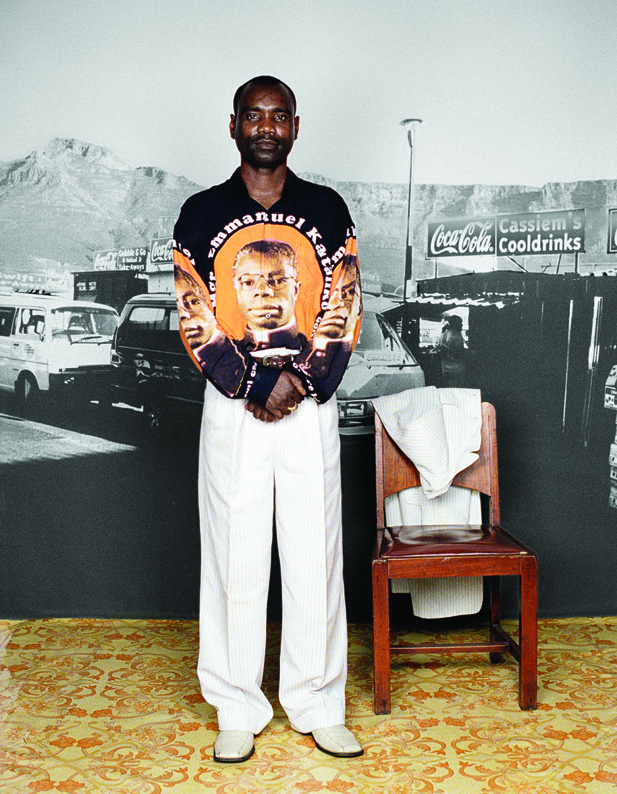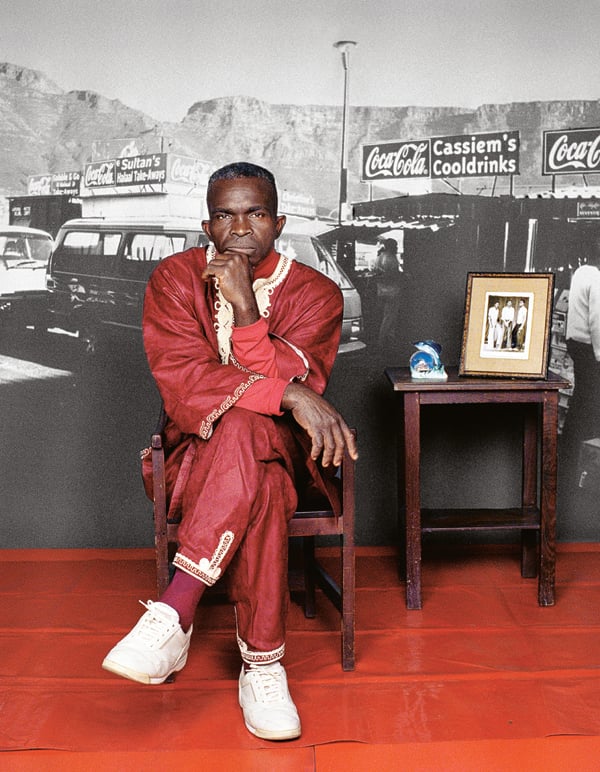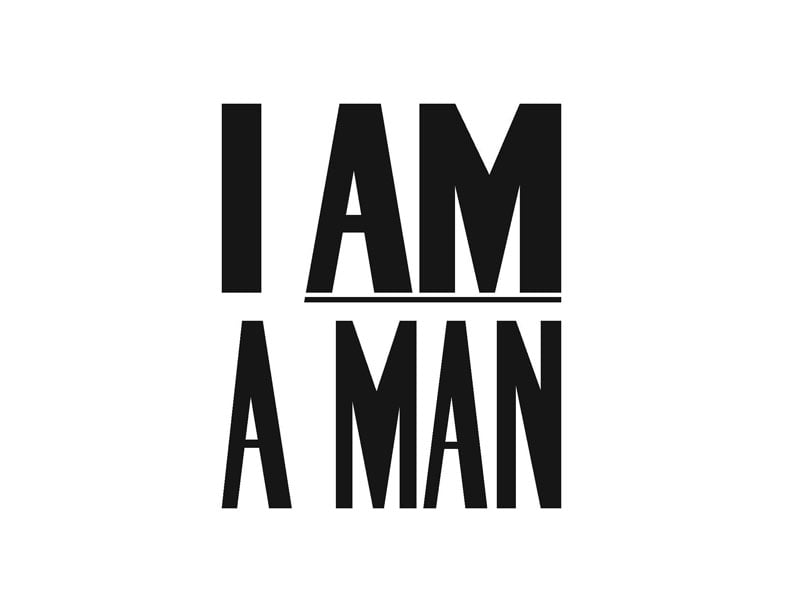
© » KADIST
D’Angelo Lovell Williams
On January 7th, 2020, artist D’Angelo Lovell Williams was diagnosed with HIV. Only a handful of chosen family members knew up until the public announcement that coincided with the release of this body of work. According to the artist, “discovery” is key to this group of large photographs.

© » KADIST
Aubrey Williams
Carib Carnival illustrates Aubrey Willams’s unique artistic language, combining Pre-Columbian iconography with abstraction. A series of abstracted shapes that resemble bones, masks and serpent-like images surrounded by fiery vapors and gases, illustrate the destruction of culture as one of the predominant themes of Williams’s work. He considered the Mayan and Aztec cultures to exemplify a number of present-day faults; according to Williams they developed technologies that would eventually lead to their own destruction.

© » KADIST
Juan Covelli
El Salto (The Jump/The Waterfall) by Juan Covelli depicts the Salto de Tequendama, a waterfall located on the outskirts of southwest Bogota. During the 19th and 20th centuries, the waterfall served as a national symbol that captured both the singularity of its geographical reference point, as well as the romantic experience of nature and immensity. The video installation arises from a detailed archive research into historic representations of Colombian landscape and reflection on their role in the present-day imaginary of the country and the wider world.

© » KADIST
Sue Williamson
In her 2003 series “Better Lives”, Sue Williamson explores stories of immigrants in search of a better life in a historically contentious South Africa. In an attempt to address and confront xenophobia in South African history, Better Lives series subverts racism and prejudice by emphasizing the immigrant as human, and thus gives the subjects a voice. “Better Lives: Richard Belalufu” tells a tale of surviving in a hostile South Africa through the undercurrent reflections on violence, abuse and the difficulty of finding home as an immigrant.

© » KADIST
Matthew Angelo Harrison
In Hole #1 a zebra scull stands in as a representation of Africa, while the plexiglass box and the hole made through it represent the inaccessibility of that culture to African-Americans.

© » KADIST
William E. Jones
His series, The Golden State, harkens back to his early career and his photographic training. Using a still camera to compose the fifty images of the series, Jones turns his lens on the vernacular architecture of California’s southern region, looking at the iconic and idiosyncratic spaces that define a region. William E. Jones is a filmmaker, writer, and artist whose interests lie in the circulation of images—images that are broadcast, images that are hidden, and images that become imbedded in our collective consciousness.

© » KADIST
Sue Williamson
In her 2003 series “Better Lives”, Sue Williamson explores stories of immigrants in search of a better life in a historically contentious South Africa. In an attempt to address and confront xenophobia in South African history, Better Lives series subverts racism and prejudice by emphasizing the immigrant as human, and thus gives the subjects a voice. “Better Lives: Richard Belalufu” tells a tale of surviving in a hostile South Africa through the undercurrent reflections on violence, abuse and the difficulty of finding home as an immigrant.

© » KADIST
William E. Jones
In the early 20th century, the Hercules Engine Company was doing a brisk business producing customized, heavy-duty engines. Seventy years later, when the United States military started opting for Humvees and stock parts, the company began to fail, and it entirely ceased production in 1999. Hercules Engines, Abandoned, Canton, Ohio (2011) depicts the manufacturer’s former productive core, gone fallow.

© » KADIST
William E. Jones
In Restaurant, Canton, Ohio (2011), a convenience store offers food, liquor, and Coca Cola to an empty street. A series of boarded-up storefronts marred by peeling paint conveys a sense of the pre- or post-apocalyptic—the hush just before or after a disaster. The reds, pinks, and oranges of the buildings give off warmth, but the absence of human activity makes the glow eerie and strange.

© » KADIST
William E. Jones
Killed is a video projection in which William E. Jones appropriated and edited, in a rapid sequence, a selection from the more than 68,000 censored or discarded films produced by the Farm Security Administration’s photographers between 1935 and 1943. Roy Emerson Stryker, the then director of the program, was in charge of what he called “killing” negatives by punching holes in them to render them unusable. Killed continues Jones’s use of discarded film footage seen in his video created from vintage 1970s and 1980s gay porn that was included in the 2008 Whitney Biennial.

© » KADIST
Matthew Angelo Harrison
In Bodily Study of Unthinking Groups, Harrison combines two disparate materials into one stratified stack: automotive clay (used in detailing cars) forms the earthy base, while fragments of zebra skull become imbedded in this falsified soil. Harrison’s forged archeological artifact compresses two cultural contexts together: that of Africa, represented by the bleached zebra skull; and that of Detroit, the birthplace of the American car. Detroit’s Matthew Angelo Harrison works at the intersection of sculpture and technology, building his own 3D printers (which rise to the status of sculpture), and using these creations to formulate others.

© » KADIST
Hank Willis Thomas
The image is borrowed from protests during Civil Rights where African Americans in the south would carry signs with the same message to assert their rights against segregation and racism. Historically, in countries such as the US and South Africa, the term “boy” was used as a pejorative and racist insult towards men of color, slaves in particular, signifying their alleged subservient status as being less than men. In response, Am I Not A Man And A Brother?

© » KADIST
Hank Willis Thomas
Drawing & Print (Drawing & Print)
Intentionally Left Blanc alludes to the technical process of its own (non)production; a procedure known as retro-reflective screen printing in which the image is only fully brought to life through its exposure to flash lighting. Using a found photograph depicting a passionate crowd of African Americans—their attitude suggesting the fervor of a civil-rights era audience— Intentionally Left Blanc reverts in its exposed, “positive” format to an image in which select faces are whitened out and erased, the exact inverse of the same view in its “negative” condition. This dialectic of light and dark re-emerges when we view the same faces again, only this time black and featureless, a scattering of disembodied heads amidst a sea of white.

© » KADIST
Hank Willis Thomas
Bread and Roses takes its name from a phrase famously used on picket signs and immortalized by the poet James Oppenheim in 1911. “Bread for all, and Roses, too’—a slogan of the women in the West,” is Oppenheim’s opening line, alluding to the workers’ goal for wages and conditions that would allow them to do more than simply survive. Thomas’ painting includes several black, white, brown, yellow, and red raised fists—clenched and high in the air in the internationally recognized symbol of solidarity, resistance, and unity.

© » KADIST
Hank Willis Thomas
Drawing & Print (Drawing & Print)
Thomas’ lenticular text-based works require viewers to shift positions as they view them in order to fully absorb their content. Meaning, therefore, changes depending on one’s perspective—and in the case of Thomas’ installation, only emerges when one knows that there is always something hidden, always more to one of his works than immediately meets the eye. This lenticular print with text shifts as you walk in front of it from its title, “Black Imitates White” to the inverse, “White Imitates Black”(and some other possibilities in between) emphasizing that there are always at least two perspectives to the same scenario, and thereby encouraging us as viewers to consider them all together rather than trying to identify with any one subjectivity.

© » KADIST
Hank Willis Thomas
Like many of his other sculptural works, the source of I am the Greatest is actually a historical photograph of an identical button pin from the 1960s. I am the Greatest presents the famous quote by Mohammad Ali to think about his important presence in the African American community. In dialogue with the painting I am a Man, also in the Kadist collection, this assertion that begins the same way takes the line from the protest poster several steps further.

© » KADIST
Hank Willis Thomas
Drawing & Print (Drawing & Print)
Shot in black and white and printed on a glittery carborundum surface, Black Hands, White Cotton both confronts and abstracts the subject of its title. As with many of his works, the artist has taken a found image and manipulated it to draw out and dramatize the formal contrast between the black hands holding white cotton. Cotton, of course is one of the most familiar fabric sources to us, and becomes incredibly soft once processed.

© » KADIST
Hank Willis Thomas
South Africa Righteous Space by Hank Willis Thomas is concerned with history and identity, with the way race and ‘blackness’ has not only been informed but deliberately shaped and constructed by various forces – first through colonialism and slavery, and more recently through mass media and advertising – and reminds us of the financial and economic stakes that have always been involved in representations of race.
Hank Willis Thomas
- location: New York, New York
- year born: 1976
- gender: male
- nationality: American
- home town: Plainfield, New Jersey
Sue Williamson
Sue Williamson (b...
Matthew Angelo Harrison
Detroit’s Matthew Angelo Harrison works at the intersection of sculpture and technology, building his own 3D printers (which rise to the status of sculpture), and using these creations to formulate others...
Aubrey Williams
Aubrey Williams was one of the founding members of the Caribbean Artists Movement, formed in the 1960s in the United Kingdom, after settling there in the early 1950s...
Juan Covelli
Juan Covelli uses technology as a medium;, striving to decolonize the museum through digital practices, he releases archives from institutional control for the sake of emancipation...
-
1970-1979
Aubrey Williams
1972Carib Carnival illustrates Aubrey Willams’s unique artistic language, combining Pre-Columbian iconography with abstraction...
-
2000-2009
William E. Jones
2000His series, The Golden State, harkens back to his early career and his photographic training...
Sue Williamson
2003In her 2003 series “Better Lives”, Sue Williamson explores stories of immigrants in search of a better life in a historically contentious South Africa...
Sue Williamson
2003In her 2003 series “Better Lives”, Sue Williamson explores stories of immigrants in search of a better life in a historically contentious South Africa...
-
2010-2019
William E. Jones
2011In the early 20th century, the Hercules Engine Company was doing a brisk business producing customized, heavy-duty engines...
William E. Jones
2011In Restaurant, Canton, Ohio (2011), a convenience store offers food, liquor, and Coca Cola to an empty street...
Hank Willis Thomas
Drawing & Print
2012(Drawing & Print) Intentionally Left Blanc alludes to the technical process of its own (non)production; a procedure known as retro-reflective screen printing in which the image is only fully brought to life through its exposure to flash lighting...
Hank Willis Thomas
2012Bread and Roses takes its name from a phrase famously used on picket signs and immortalized by the poet James Oppenheim in 1911...
Hank Willis Thomas
Drawing & Print
2012(Drawing & Print) Thomas’ lenticular text-based works require viewers to shift positions as they view them in order to fully absorb their content...
Hank Willis Thomas
2012Like many of his other sculptural works, the source of I am the Greatest is actually a historical photograph of an identical button pin from the 1960s...
Hank Willis Thomas
2013The image is borrowed from protests during Civil Rights where African Americans in the south would carry signs with the same message to assert their rights against segregation and racism...
Hank Willis Thomas
Drawing & Print
2014(Drawing & Print) Shot in black and white and printed on a glittery carborundum surface, Black Hands, White Cotton both confronts and abstracts the subject of its title...
Hank Willis Thomas
2014South Africa Righteous Space by Hank Willis Thomas is concerned with history and identity, with the way race and ‘blackness’ has not only been informed but deliberately shaped and constructed by various forces – first through colonialism and slavery, and more recently through mass media and advertising – and reminds us of the financial and economic stakes that have always been involved in representations of race....
Matthew Angelo Harrison
2015In Hole #1 a zebra scull stands in as a representation of Africa, while the plexiglass box and the hole made through it represent the inaccessibility of that culture to African-Americans....
Matthew Angelo Harrison
2016In Bodily Study of Unthinking Groups, Harrison combines two disparate materials into one stratified stack: automotive clay (used in detailing cars) forms the earthy base, while fragments of zebra skull become imbedded in this falsified soil...
D’Angelo Lovell Williams
2018On January 7th, 2020, artist D’Angelo Lovell Williams was diagnosed with HIV...
-
2020-2029
Juan Covelli
2021El Salto (The Jump/The Waterfall) by Juan Covelli depicts the Salto de Tequendama, a waterfall located on the outskirts of southwest Bogota...
